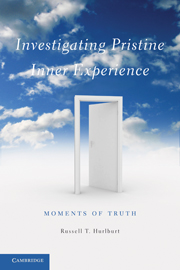Book contents
- Frontmatter
- Contents
- List of Figures and Tables
- Preface
- Acknowledgments
- 1 Moments of Truth
- 2 Fragmented Experience in Bulimia Nervosa
- 3 Apprehending Pristine Experience
- 4 Everyday Experience
- 5 Moments Are Essential
- 6 Experience in Tourette's Syndrome
- 7 The Moment (Not): Happy and Sad
- 8 Subjunctification
- 9 Before and After Experience? Adolescence and Old Age
- 10 Iteration Is Essential
- 11 Epistemological Q/A
- 12 A Consciousness Scientist as DES Subject
- 13 Pristine Experience (Not): Emotion and Schizophrenia
- 14 Multiple Autonomous Experience in a Virtuoso Musician
- 15 Unsymbolized Thinking
- 16 Sensory Awareness
- 17 The Radical Non-subjectivity of Pristine Experience
- 18 Diamonds versus Glass
- 19 Into the Floor: A Right-or-Wrong-Answer Natural Experiment
- 20 The Emergence of Salient Characteristics
- 21 Investigating Pristine Inner Experience
- Appendix: List of Constraints
- References
- Index
20 - The Emergence of Salient Characteristics
Published online by Cambridge University Press: 05 June 2012
- Frontmatter
- Contents
- List of Figures and Tables
- Preface
- Acknowledgments
- 1 Moments of Truth
- 2 Fragmented Experience in Bulimia Nervosa
- 3 Apprehending Pristine Experience
- 4 Everyday Experience
- 5 Moments Are Essential
- 6 Experience in Tourette's Syndrome
- 7 The Moment (Not): Happy and Sad
- 8 Subjunctification
- 9 Before and After Experience? Adolescence and Old Age
- 10 Iteration Is Essential
- 11 Epistemological Q/A
- 12 A Consciousness Scientist as DES Subject
- 13 Pristine Experience (Not): Emotion and Schizophrenia
- 14 Multiple Autonomous Experience in a Virtuoso Musician
- 15 Unsymbolized Thinking
- 16 Sensory Awareness
- 17 The Radical Non-subjectivity of Pristine Experience
- 18 Diamonds versus Glass
- 19 Into the Floor: A Right-or-Wrong-Answer Natural Experiment
- 20 The Emergence of Salient Characteristics
- 21 Investigating Pristine Inner Experience
- Appendix: List of Constraints
- References
- Index
Summary
In Chapter 9, we met thirteen-year-old RD, a subject in Sarah Akhter's and my exploration of the experience of early adolescents. The aim of that exploration, as you may recall, was to apprehend the phenomena of experience, whatever those phenomena happened to be. For example, at one beep RD was saying in his inner voice, “Why did he kick me in my sore knee?” His voice sounded angry, but RD didn't feel angry; he realized that he was angry only by observing the tone of his own inner voice, which he recognized to have an angry sound. That is, he inferred that he was angry, rather than felt angry. It turned out that other subjects in our small sample were similar, so we speculated that whereas young adolescents may have emotion processes and respond with emotional actions, they may not simultaneously experience that emotion. We speculated that experiencing feeling emotion is a skill that is acquired across many years.
Somehow in Chapter 9 we got from one adolescent's report about one moment (“I was saying to myself ‘Why did he kick me in my sore knee?’”) to a speculation about adolescents' experience in general (young adolescents may not experience feelings). That's quite a leap, and it involved noticing both that RD had similar lack of emotional experience on other occasions and also that other children had similar lack of emotional experience. That is, the no-emotional-experience phenomenon emerged as salient across several or many samples both within and across subjects.
- Type
- Chapter
- Information
- Investigating Pristine Inner ExperienceMoments of Truth, pp. 390 - 410Publisher: Cambridge University PressPrint publication year: 2011



